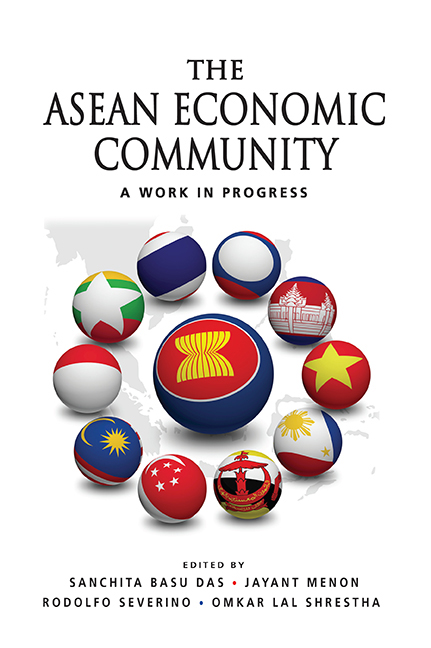Book contents
- Frontmatter
- Contents
- Foreword
- Foreword
- Preface
- acknowledgments
- Abbreviations
- The Contributors
- 1 Overview
- 2 Non-Tariff Barriers: A Challenge to Achieving the ASEAN Economic Community
- 3 ASEAN Trade in Services
- 4 The Asean Economic Community: The Investment Climate
- 5 Competition and Intellectual Property Laws in the ASEAN ‘Single Market’
- 6 Subregional Zones and ASEAN Economic Community
- 7 ASEAN FTAs: State of Play and Outlook for Asean's Regional and Global Integration
- 8 The Asean Dispute Settlement System
- 9 Enhancing the Institutional Framework for AEC Implementation: Designing Institutions that are Effective and Politically Feasible
- 10 ASEAN Economic Community Business Survey
- Index
1 - Overview
Published online by Cambridge University Press: 21 October 2015
- Frontmatter
- Contents
- Foreword
- Foreword
- Preface
- acknowledgments
- Abbreviations
- The Contributors
- 1 Overview
- 2 Non-Tariff Barriers: A Challenge to Achieving the ASEAN Economic Community
- 3 ASEAN Trade in Services
- 4 The Asean Economic Community: The Investment Climate
- 5 Competition and Intellectual Property Laws in the ASEAN ‘Single Market’
- 6 Subregional Zones and ASEAN Economic Community
- 7 ASEAN FTAs: State of Play and Outlook for Asean's Regional and Global Integration
- 8 The Asean Dispute Settlement System
- 9 Enhancing the Institutional Framework for AEC Implementation: Designing Institutions that are Effective and Politically Feasible
- 10 ASEAN Economic Community Business Survey
- Index
Summary
Executive Summary
Although the self-imposed deadline for the realization of the ASEAN Economic Community (AEC) is 2015, it should not be viewed as a hard target. One should not expect 2015 to see ASEAN suddenly transformed, its nature and processes abruptly changed, its members' interests substantially altered. Rather, 2015 should be viewed more as a milestone year — a measure of a work in progress — rather than as a hard target year.
Yet, ASEAN member countries did commit to carry out certain time-bound specific measures that are intended to lead to regional economic integration. While ASEAN should not be called to account for its members' failure to make good on their commitments, any failure to deliver will likely lead to a loss of credibility, putting member countries in danger of falling further behind in the global competition for export markets and Foreign Direct Investment (FDI).
The experts commissioned by the Asian Development Bank (ADB) and the Institute of Southeast Asian Studies (ISEAS) to write chapters on this matter express considerable doubt as to whether the specific measures committed to in the AEC Blueprint will have been carried out by 2015. One chapter notes ASEAN's failure to do away with NTBs. Another chapter cites the lack of progress in liberalizing intra-regional trade in services, which is becoming increasingly important in Southeast Asia. Still another attributes ASEAN's failure to recover its attractiveness to FDI to the region's inability, whether real or perceived, to integrate its economy. The chapter on competition law and Intellectual-Property Rights (IPR) protection in ASEAN concludes that, although “harmonizing” rules and enforcement measures relative to competition and intellectual property is important for bringing down trade barriers, such harmonization would both be difficult and time consuming. The chapter on subregional zones similarly observes that, although mutual confidence and functioning institutions are essential to transnational endeavors, they take time to build; however, subregional zones can help reduce development gaps and improve connectivity across national boundaries. The chapter on free trade agreements states that ASEAN “has no prospect of coming close to … (a) single market by the AEC's 2015 deadline — or even by 2020 or 2025”.
- Type
- Chapter
- Information
- The ASEAN Economic CommunityA Work in Progress, pp. 1 - 30Publisher: ISEAS–Yusof Ishak InstitutePrint publication year: 2013

